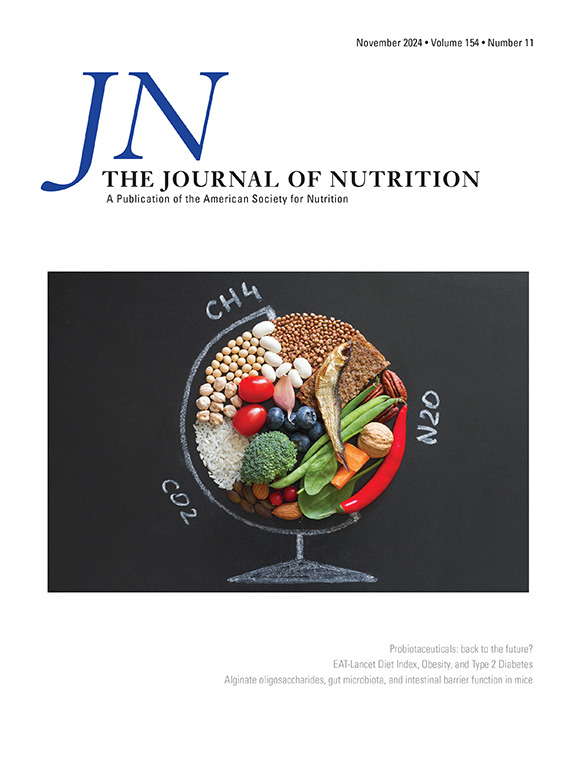Continuous Exposure of Nonobese Adult Male Rats to a Soft-Textured, Readily Absorbable Diet Induces Insulin Resistance and Derangements in Hepatic Glucose and Lipid Metabolism
IF 3.7
3区 医学
Q2 NUTRITION & DIETETICS
引用次数: 0
Abstract
Background
Type 2 diabetes (T2D) is characterized by insulin resistance and defective insulin secretion. Previously, we found that rats fed soft pellets (SPs) on a 3-h restricted schedule over 14 wk demonstrated glucose intolerance and insulin resistance with disruption of insulin signaling.
Objectives
This study aims to determine 1) the time required for an SP diet to induce insulin resistance, and 2) whether the metabolic derangements in rats fed SPs can be reversed by changing to a standard control diet.
Methods
We performed glucose tolerance tests and calculated the homeostasis model assessment of insulin resistance (HOMA-IR) to evaluate the insulinemic response to glucose and assess insulin resistance in nonobese male rats fed control pellets (CPs) or SPs on a 3–h restricted schedule (10:00–13:00) for 4 and 9 wk. At 11 wk, we switched half of the insulin-resistant SP group to CPs [soft-to-control pellets (SCPs)] and after an additional 11 wk evaluated changes in glucose and lipid metabolism across the 3 groups.
Results
The glucose tolerance test results in the SP and CP rats did not differ at 4 or 9 wk. The insulin levels in the SP group were higher than in the CP group at both time points (P < 0.05). The HOMA-IR was significantly higher in the SP rats at 9 wk compared with the controls (P < 0.05). At 22 wk, the HOMA-IR, blood glucose levels at 30 min after initiating feeding, hepatic glucose metabolism, and lipid synthesis in rats fed SPs continuously were significantly greater than in those fed CPs (P < 0.05); however, these values in the SCP rats did not differ from those in the CP rats.
Conclusions
A continuous diet of soft-textured, readily absorbable food may be an important and reversible underlying driver in T2D pathogenesis.
将非肥胖成年雄性大鼠持续暴露于质地柔软、易于吸收的饮食中,可诱导胰岛素抵抗和肝脏糖脂代谢紊乱。
背景:2型糖尿病(T2D)以胰岛素抵抗和胰岛素分泌缺陷为特征。先前,我们发现,在14周的时间里,按3小时的限制时间喂食软粒(SPs)的大鼠表现出葡萄糖耐受不良和胰岛素抵抗,并伴有胰岛素信号的破坏。目的:确定(1)SP日粮诱导胰岛素抵抗所需的时间,(2)SP日粮是否可以通过改为标准对照日粮来逆转大鼠的代谢紊乱。方法:采用糖耐量试验,计算胰岛素抵抗稳态模型评估(HOMA-IR),以评估非肥胖雄性大鼠对葡萄糖的胰岛素反应,并评估在3小时限制时间表(10:00至13:00)饲喂对照颗粒(CPs)或SPs的4周和9周的胰岛素抵抗。在11周时,我们将一半的胰岛素抵抗SP组切换到CPs(软控颗粒[scp]),并在另外11周后评估三组的葡萄糖和脂质代谢变化。结果:SP大鼠和CP大鼠在第4周和第9周的糖耐量试验结果无显著差异。两个时间点SP组胰岛素水平均高于CP组(P < 0.05)。SP大鼠9周时HOMA-IR明显高于对照组(P < 0.05)。22周时,连续饲喂SPs的大鼠HOMA-IR、饲喂后30分钟血糖水平、肝脏糖代谢和脂质合成均显著高于饲喂CPs的大鼠(P < 0.05);然而,SCP大鼠的这些值与CP大鼠没有差异。结论:持续食用质地柔软、易于吸收的食物可能是t2dm发病的重要且可逆的潜在驱动因素。
本文章由计算机程序翻译,如有差异,请以英文原文为准。
求助全文
约1分钟内获得全文
求助全文
来源期刊

Journal of Nutrition
医学-营养学
CiteScore
7.60
自引率
4.80%
发文量
260
审稿时长
39 days
期刊介绍:
The Journal of Nutrition (JN/J Nutr) publishes peer-reviewed original research papers covering all aspects of experimental nutrition in humans and other animal species; special articles such as reviews and biographies of prominent nutrition scientists; and issues, opinions, and commentaries on controversial issues in nutrition. Supplements are frequently published to provide extended discussion of topics of special interest.
 求助内容:
求助内容: 应助结果提醒方式:
应助结果提醒方式:


